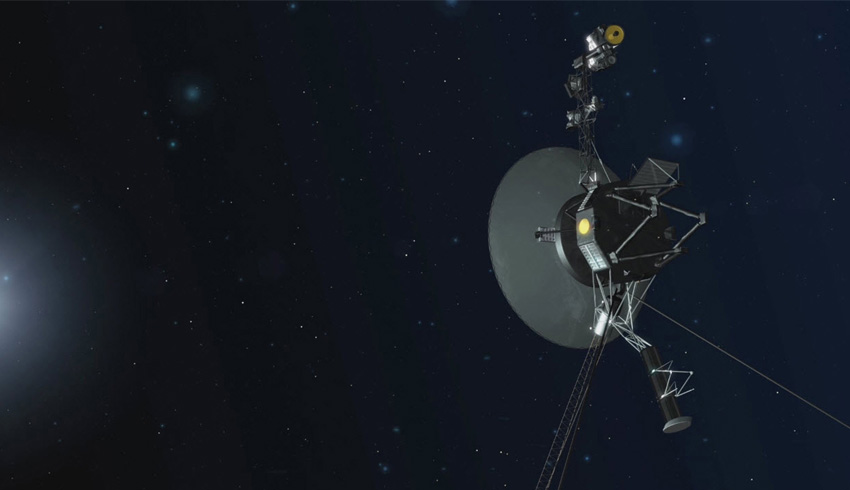At a distance of about 18 billion kilometres from Earth – well beyond the orbit of Pluto – Voyager 2 had entered interstellar space, or the region between stars. Today, five new research papers in the journal Nature Astronomy describe what scientists observed during and since Voyager 2's historic crossing.
Each paper details the findings from one of Voyager 2's five operating science instruments: a magnetic field sensor, two instruments to detect energetic particles in different energy ranges and two instruments for studying plasma (a gas composed of charged particles).
Taken together, the findings help paint a picture of this cosmic shoreline, where the environment created by our sun ends and the vast ocean of interstellar space begins.
The sun's heliosphere is like a ship sailing through interstellar space. Both the heliosphere and interstellar space are filled with plasma, a gas that has had some of its atoms stripped of their electrons.
Ed Stone, project scientist for Voyager and a professor of physics at Caltech, said, "The Voyager probes are showing us how our sun interacts with the stuff that fills most of the space between stars in the Milky Way galaxy. Without this new data from Voyager 2, we wouldn't know if what we were seeing with Voyager 1 was characteristic of the entire heliosphere or specific just to the location and time when it crossed."
The plasma inside the heliosphere is hot and sparse, while the plasma in interstellar space is colder and denser. The space between stars also contains cosmic rays, or particles accelerated by exploding stars. Voyager 1 discovered that the heliosphere protects Earth and the other planets from more than 70 per cent of that radiation.
When Voyager 2 exited the heliosphere last year, scientists announced that its two energetic particle detectors noticed dramatic changes: the rate of heliospheric particles detected by the instruments plummeted, while the rate of cosmic rays (which typically have higher energies than the heliospheric particles) increased dramatically and remained high. The changes confirmed that the probe had entered a new region of space.
Before Voyager 1 reached the edge of the heliosphere in 2012, scientists didn't know exactly how far this boundary was from the sun.
The two probes exited the heliosphere at different locations and also at different times in the constantly repeating, approximately 11-year solar cycle, over the course of which the sun goes through a period of high and low activity.
Scientists expected that the edge of the heliosphere, called the heliopause, can move as the sun's activity changes, sort of like a lung expanding and contracting with breath. This was consistent with the fact that the two probes encountered the heliopause at different distances from the sun.
The two Voyager spacecraft have now confirmed that the plasma in local interstellar space is significantly denser than the plasma inside the heliosphere, as scientists expected. Voyager 2 has now also measured the temperature of the plasma in nearby interstellar space and confirmed it is colder than the plasma inside the heliosphere.
In 2012, Voyager 1 observed a slightly higher-than-expected plasma density just outside the heliosphere, indicating that the plasma is being somewhat compressed.
Voyager 2 observed that the plasma outside the heliosphere is slightly warmer than expected, which could also indicate it is being compressed (the plasma outside is still colder than the plasma inside).
Voyager 2 also observed a slight increase in plasma density just before it exited the heliosphere, indicating that the plasma is compressed around the inside edge of the bubble. But scientists don't yet fully understand what is causing the compression on either side.
An observation by Voyager 2's magnetic field instrument confirms a surprising result from Voyager 1: the magnetic field in the region just beyond the heliopause is parallel to the magnetic field inside the heliosphere.
With Voyager 1, scientists had only one sample of these magnetic fields and couldn't say for sure whether the apparent alignment was characteristic of the entire exterior region or just a coincidence. Voyager 2's magnetometer observations confirm the Voyager 1 finding and indicate that the two fields align, according to Stone.
The Voyager probes launched in 1977, and both flew by Jupiter and Saturn. Voyager 2 changed course at Saturn in order to fly by Uranus and Neptune, performing the only close fly-bys of those planets in history.
The Voyager probes completed their Grand Tour of the planets and began their Interstellar Mission to reach the heliopause in 1989. Voyager 1, the faster of the two probes, is currently over 22 billion kilometres from the sun, while Voyager 2 is 18.2 billion kilometres from the sun. It takes light about 16.5 hours to travel from Voyager 2 to Earth.
By comparison, light travelling from the sun takes about eight minutes to reach Earth.

